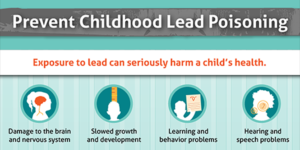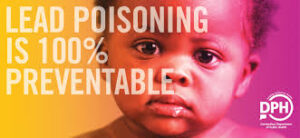Advocate
There is probably nothing that compels a person to become an expert on a health issue more than if it impacts their child. I had become an enthusiastic and informed advocate because my daughter, Imani, contracted lead poisoning. Lead exposure in childhood can lead to learning disabilities, poor school performance, behavioral issues, and self-regulation deficits. I recall being so frightened by the ominous words, “permanent and irreversible brain damage.” Those words led me to become super informed and to connect my two-year-old with every available early intervention resource. I also became a fierce advocate for preventing lead poisoning. At the age of 27, I found myself speaking about the dangers of lead poisoning before the MD General Assembly, appointed by the Governor to serve a four-year term on a state commission, recognized by the MD Attorney General, and featured in public service announcements.
Higher Risk for Children
Children are more at risk for the damaging effects of lead than adults because children’s bodies absorb more lead, and their brains and nervous systems are more susceptible to damage from lead poisoning. While the severity of symptoms can depend on the level of lead in a child’s blood, there is no safe level of lead exposure in children. My daughter’s lead level was so high that she required hospitalization and treatment through a process called chelation therapy.
Lead Paint in Older Homes
While stories of lead in toys or food items often make the news, childhood lead poisoning is primarily attributed to the presence of lead-based paint in older housing. In Pennsylvania, nearly 9,000 young children suffer from lead poisoning each year. While this type of paint was banned for residential use in 1978, Pennsylvania ranks fifth in the country for old housing, with 70 percent of residential units having been built prior to 1980. Children who reside in or frequent old housing stock are often exposed due to peeling or chipping paint, cracked walls and aged window sills, which can easily result in the ingestion or inhalation of fine lead dust. The source of my daughter’s lead poisoning was a home she visited frequently.
Remediation
One way to prevent children from being exposed to lead is remediation, which is designed to eliminate lead hazards in a home. By implementing lead remediation practices like modernizing windows, repairing cracks in walls and freshly painting surfaces, we can prevent children from being exposed to lead and ensure that they are healthier and free of completely avoidable health challenges. On the state or county level, there is even funding available to help renters and property owners make or keep their units lead safe.
Need Help?
For more information on how to reduce lead paint poisoning risks or get assistance with remediation efforts, contact your county health department, planning commission, or the PA State Department of Health.
*Joe Studivant BS, Permanency Coordinator, JFS Adoption & Foster Care





